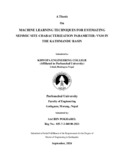Please use this identifier to cite or link to this item:
https://elibrary.khec.edu.np/handle/123456789/854| Title: | Machine Learning Techniques f or Estimating Seismic Site Characterization Parameter: Vs30 in The Kathmandu Basin |
| Authors: | Sachin Pokharel |
| Advisor: | Dr. Subeg Man Bijukchhen; Er. Sunil Duwal |
| Issue Date: | 2024 |
| College Name: | Khwopa Engineering College |
| Level: | Masters |
| Degree: | ME Earthquake |
| Department Name: | P. G. Department of Earthquake Engineering |
| Abstract: | Seismic site characterization is essential for assessing earthquake hazards, and Vs30 is a pivotal parameter in this process. Vs30 refers to the average shear wave velocity of the top 30 meters of soil and is a critical factor in determining the seismic response of a site. It influences the classification of seismic site conditions and helps predict the impact of earthquakes on structures and infrastructure. In this work, we explores seismic site characterization parameter, Vs30 and its estimation within the Kathmandu Basin through the machine learning techniques. Utilizing a comprehensive dataset of 370 stations, the study employs ArcGIS for data normalization and spatial analysis, incorporating a range of attributes to create detailed maps reflecting various site characteristics. The methodology involves evaluating feature importance using Information Gain Ratio (IGR), and addressing multicollinearity through Variance Inflation Factors (VIF) and Pearson Correlation Coefficients. Predictive models, including Random Forest (RF), Support Vector Regression (SVR), Extreme Gradient Boosting (XGBoost), and Artificial Neural Network (ANN) are applied with optimized parameters to analyze their performance and impact on Vs30. The coding and model implementation is conducted using Python�s Scikit Learn library in Jupyter Notebook. The findings provide valuable insights into the factors affecting seismic site characteristics. RF shows the best performance relative to the data's scale with RMSE value of 90.2616 m/s and MAPE value of 0.1815 surpassing other models. This research demonstrates machine learning techniques, offering an approach for seismic site evaluation and contributing to improved earthquake hazard assessment in the Kathmandu Basin. |
| URI: | https://elibrary.khec.edu.np:8080/handle/123456789/854 |
| Appears in Collections: | Master of Science (M.Sc) in Earthquake engineering |
Files in This Item:
| File | Description | Size | Format | |
|---|---|---|---|---|
| 021_Sachin Pokharel.pdf Restricted Access | 3.48 MB | Adobe PDF |  View/Open Request a copy |
Items in DSpace are protected by copyright, with all rights reserved, unless otherwise indicated.
